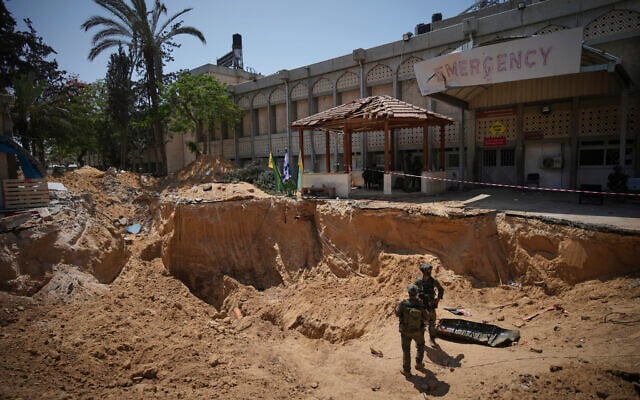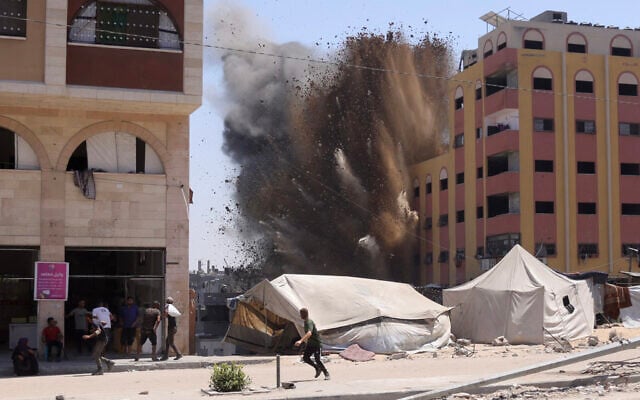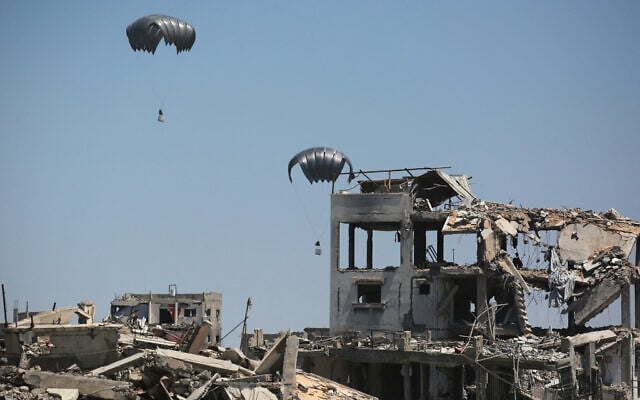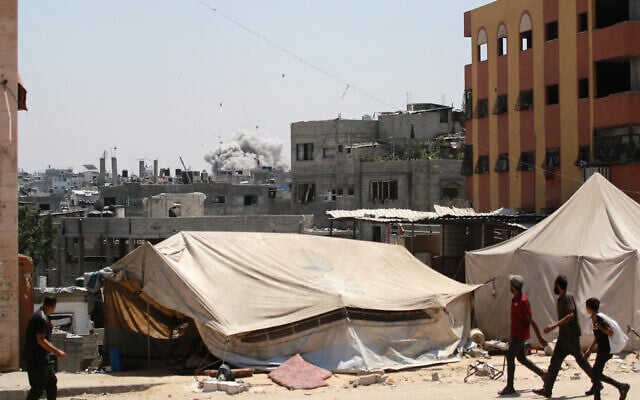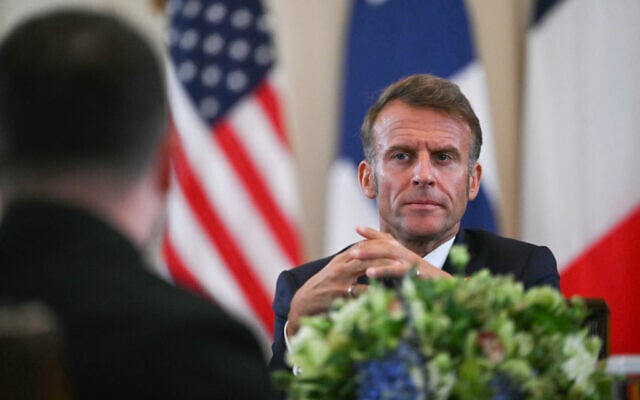


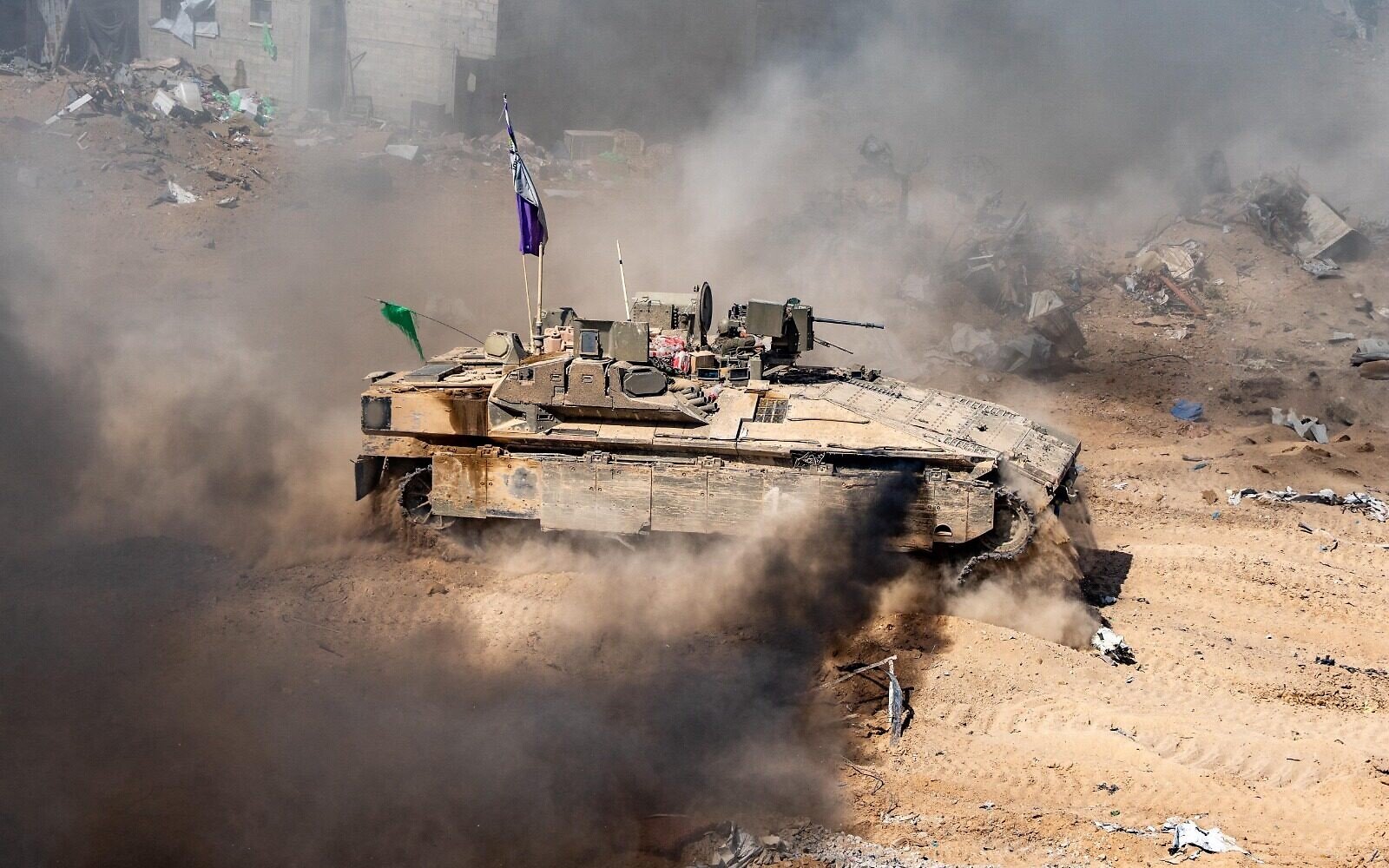
Since the end of the last ceasefire in the Gaza Strip in March, the Israel Defense Forces has eliminated over 2,100 terror operatives in the fighting there, including many senior Hamas commanders and other leaders in the terror group, the military said Wednesday.
The Hamas-run health ministry in Gaza says 10,576 Palestinians have been killed in that time, without differentiating between combatants and civilians. Neither figure can be independently verified.
Over 10,000 terror targets have been struck by Israeli Air Force fighter jets, helicopters and drones as well as Navy vessels since March 18, the military said.
The IDF said it currently has “operational control” over 75 percent of the Strip’s territory, which was achieved during the army’s latest offensive.
“The operational control in the area enabled the IDF to significantly expand its activity, thereby dealing blows to the capabilities and terror infrastructure of the Hamas terror organization and disrupting its chain of command,” the military said.
The most significant strike carried out since March was the bombing that eliminated of Mohammed Sinwar, the Hamas leader in Gaza and brother of the late Hamas leader Yahya Sinwar, whom Israel killed last year; Muhammad Shabana, commander of the terror group’s Rafah Brigade; and Mahdi Quara, commander of the South Khan Younis Battalion.
The three, along with other operatives, were killed on May 13 while hiding in a tunnel under the European Hospital in Khan Younis.
The IDF said it had also killed several Hamas government leaders, internal security officers, six top commanders in the terror group’s naval commando forces, and dozens of terrorists who invaded Israel during the October 7, 2023, onslaught — in which 1,200 people, mostly civilians, were killed, and 251 taken hostage.
Fighting resumed in March after the collapse of a 60-day ceasefire-hostage release deal.
According to the IDF, its offensive against Hamas in recent months “dealt a blow to the combat and command capabilities of the terror organizations in the Gaza Strip” and “created favorable operational conditions intensifying the pressure on the Hamas terror organization and degrading its remaining capabilities.
“These achievements constitute the basis for the next moves of the IDF in the Gaza Strip,” the military said, referring to the upcoming planned offensive in Gaza City.
The IDF has called up tens of thousands of reservists for the major offensive, which has drawn outrage across the international community, as well as hostage families, who fear the operation will be a death sentence for their loved ones.
IDF Spokesman Brig. Gen. Effie Defrin said in a press conference on Wednesday that Hamas was a “battered and bruised guerrilla organization” following the IDF’s latest operation.
“We will deepen the blows to Hamas in Gaza City, a terror stronghold… We will deepen the blows to the terror infrastructure above and below ground, and cut the population’s reliance on Hamas,” he said.
Defrin said the IDF “is not waiting” and has already begun preliminary operations in Gaza City, ahead of the offensive aimed at capturing the city.
“IDF troops are already taking control of the outskirts of Gaza City,” he said.
Meanwhile, aircraft from Jordan, the United Arab Emirates, Germany, the Netherlands, France, Singapore and Indonesia airdropped 154 pallets of humanitarian aid in the Gaza Strip on Wednesday, the IDF said.
Each pallet contained several hundred kilograms of food, according to the military.
Indonesia, the country with the largest Muslim population in the world, does not have relations with Israel.
Prime Minister Benjamin Netanyahu has dismissed reports of starvation in Gaza as “lies” promoted by Hamas. But facing heavy international pressure, in July the government instituted a series of measures to alleviate hunger in the Strip, including airdrops and 10-hour “humanitarian pauses” in military operations in three population centers to allow deliveries of aid.
Earlier in August, for the first time in nearly a year, Israel announced it would allow the entry of goods into Gaza through the private sector, an effort aimed at increasing the flow of essential food and hygiene items that were previously only delivered by aid organizations.
The US- and Israel-backed Gaza Humanitarian Foundation (GHF), established to provide aid via an alternative that would keep goods out of Hamas’s hands, has been plagued by near-daily shooting incidents, in which the UN has said seen more than 1,000 killed as they try to reach the GHF distribution centers, allegedly by IDF gunfire.
Officials from five aid groups, including UN agencies, told Reuters on Wednesday they have not yet been able to deliver shelter materials to Gaza despite Israeli authorities saying they have lifted restrictions on such supplies, and warned that further delays could cause more Palestinian deaths.
“The United Nations and our partners have…not been able to bring in shelter materials following the Israeli announcement,” the UN Office for the Coordination of Humanitarian Affairs (OCHA) spokesperson Jens Laerke said.
“There’s a set of impediments that still needs to be addressed, including Israeli customs clearance.”
CARE International, ShelterBox and the Norwegian Refugee Council also said they had not yet received any authorization to deliver shelter materials. Another international NGO, which declined to be identified, said it had been unable to deliver such supplies but was trying to get clearance.
Over 1.3 million Gazans lack tents, the United Nations said this month, and more people are expected to be displaced by the planned operation to seize Gaza City.
COGAT, the military agency that coordinates aid, did not immediately respond to Reuters’ questions. It has previously said it invests considerable efforts to ensure aid reaches Gaza and has denied restricting supplies.
After nearly two years of war, many displaced Palestinians are living in the rubble of their homes or in tents.
“Life in the tent is no life at all…There’s no proper bathroom, not even a decent place to sit. We end up sitting in the street, suffocating in the heat,” 55-year-old Ibrahim Tabassi said in the southern Gazan city of Khan Younis.
He shares his cramped tent, made from tarpaulin sheets and scrap metal, with nine other family members. Clothes and pots hang inside.
Another Gaza resident, Sanaa Abu Jamous, said that she, like many other Gazans, had been using the same tattered tent throughout the war.
“My tent is extremely worn out,” she said.
The Red Cross told Reuters it had received permission from COGAT to bring in shelter materials from what is known as the Jordanian corridor to Kerem Shalom, but that many challenges remain.
The Norwegian Refugee Council, a humanitarian organization, said it had applied for permission to deliver 3,000 tents across Gaza, including the north, but had not yet received a reply.
Many aid groups are resisting Israeli demands — under measures imposed in March — to register, because it means disclosing personal information about Palestinian staff.
COGAT says the mechanism is a security screening intended to ensure aid goes directly to the population rather than to the Hamas terror group.
ShelterBox’s regional director, Haroon Altaf, said granting permission to only a select number of aid groups would not meet demand for shelter materials.
“If it’s only a handful of organizations that can bring shelter aid in, it doesn’t really change much, and it’s deeply concerning. People are going to die because of it,” he said.
French President Emmanuel Macron said Wednesday that the planned military offensive in Gaza “can only lead to disaster for both peoples” and called instead for a permanent ceasefire, a hostage release deal, disarmament of Hamas, and an “international stabilization mission” for the Strip.
In a post on X, Macron said he had spoken with Jordan’s King Abdullah II and Egyptian President Abdel-Fattah el-Sissi, and the three leaders share the conviction that expanded Israeli action in Gaza, which is due to begin with the conquest of Gaza City, “risks plunging the entire region into a cycle of permanent war.”
Earlier this month, Netanyahu repeated his position that Israel cannot hand control of Gaza to the Palestinian Authority after the war, a position at odds with Macron’s call to strengthen the PA’s role in the Strip.
Macron noted that France will co-chair a conference on the two-state solution with Saudi Arabia in New York next month, calling it “the only credible way forward — for the families of the hostages, for Israelis, and for Palestinians alike.”
Gaza’s Hamas-run health ministry said the Palestinian death toll from 22 months of war has passed 62,000. The unverified figure does not differentiate between civilians and combatants. Israel has said it seeks to minimize civilian fatalities and stresses that Hamas uses Gaza’s civilians as human shields, fighting from civilian areas including homes, hospitals, schools and mosques.
Times of Israel staff contributed to this report.

